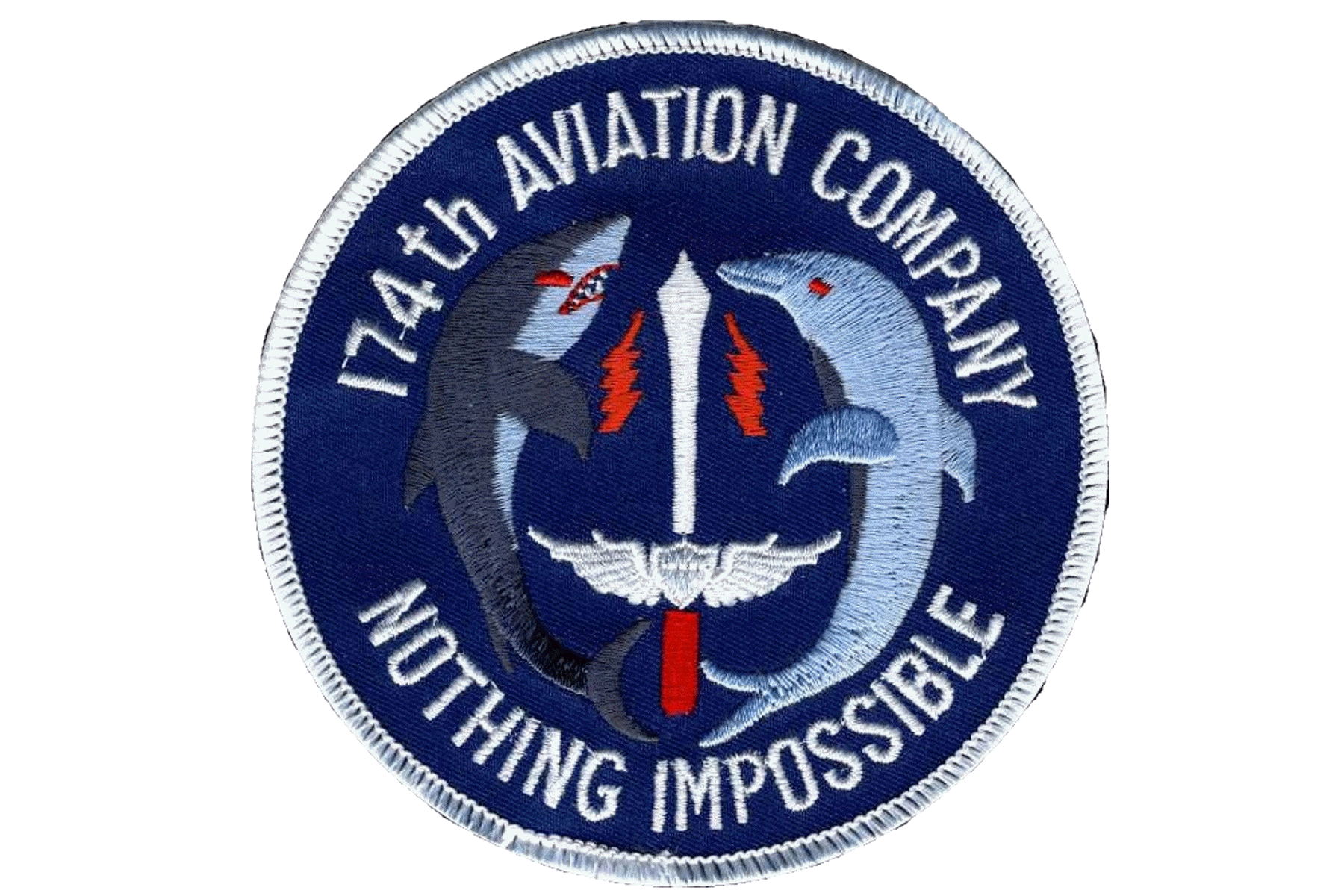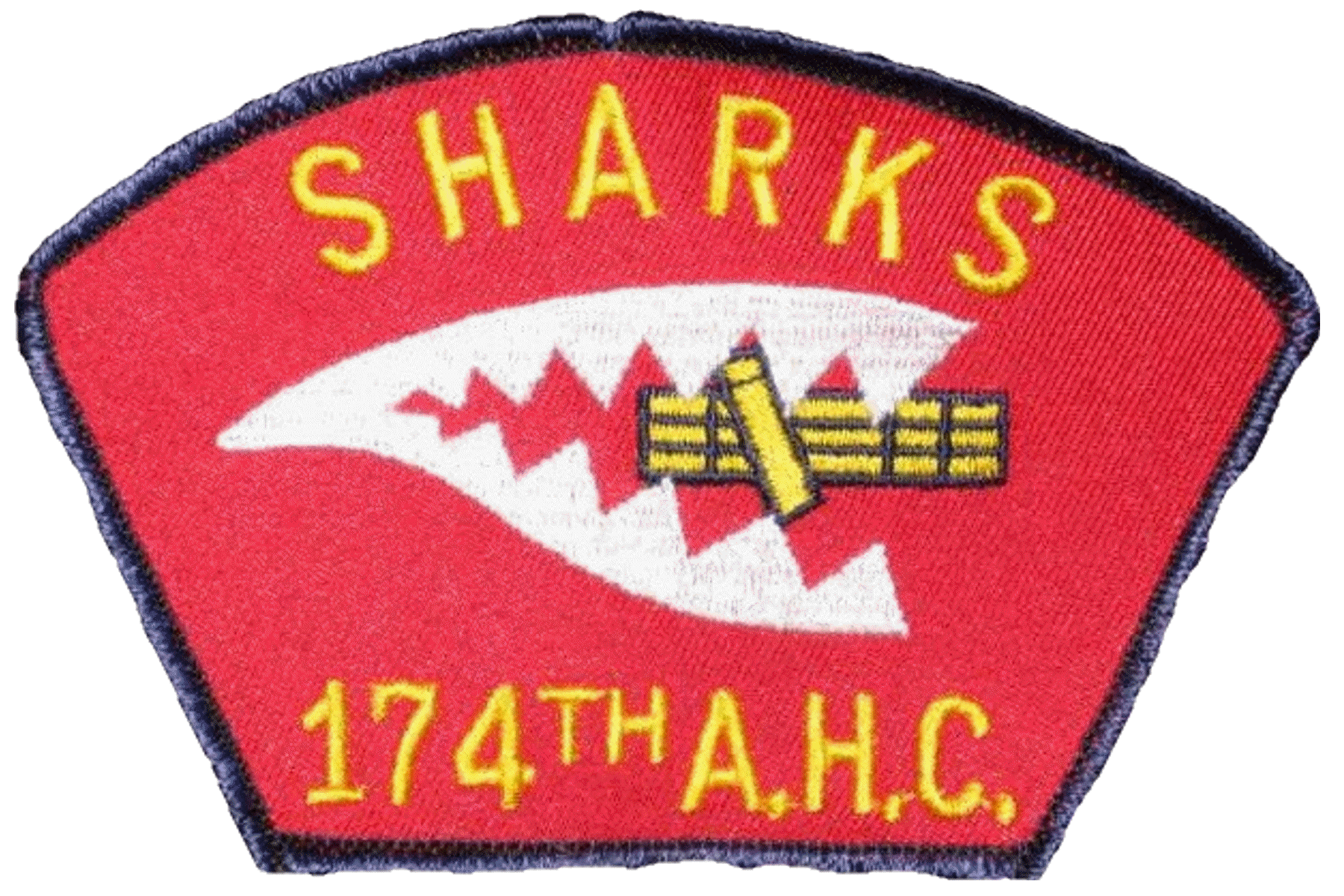A Vietnam Retrospective
PART 2
Click on the blue
cube to go back to Part 1
 ==========================
==========================
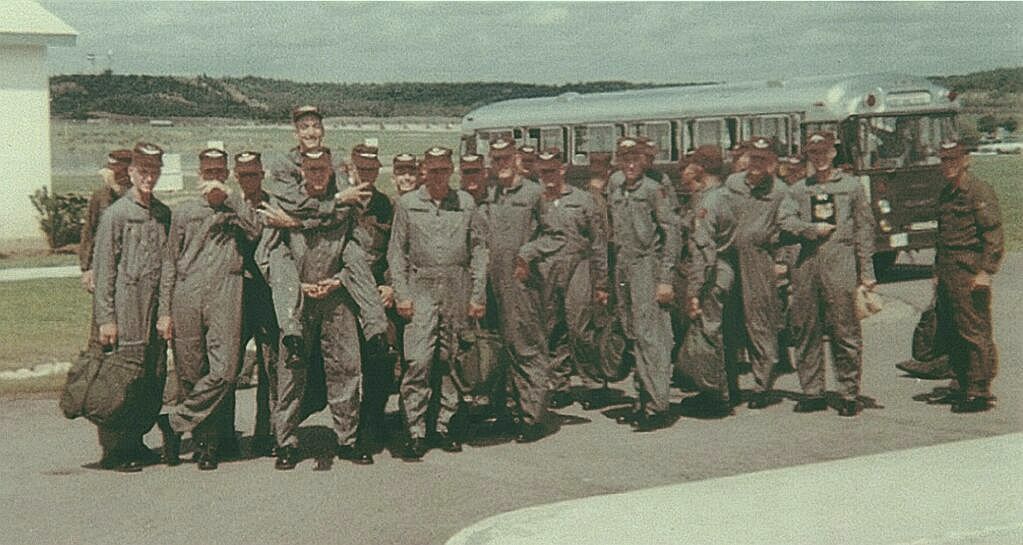
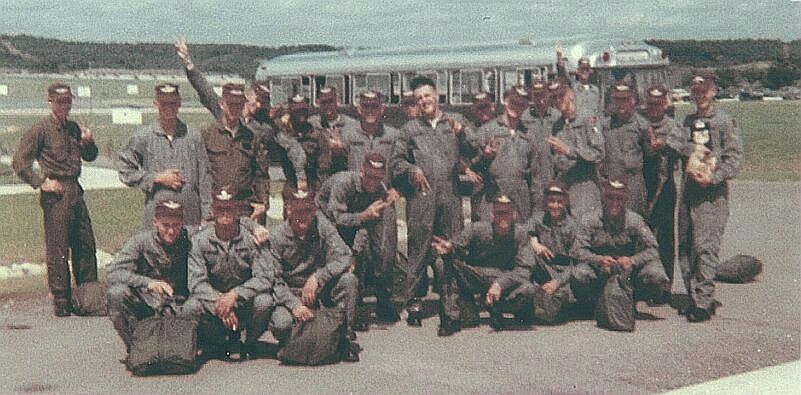
Above photos of my Flight Class 70-07, Ft.
Wolters 1970.
Departing the
commercial flight at Bien Hoa, and the initial
arrival at the replacement center there, was our introduction to the heat, humidity and
generally filthy living conditions we'd endure for the upcoming year. The raised, communal
toilets to allow catch barrels below, were a breeding ground for crabs. Due to the high
water table, human waste was burned with JP-4 (jet fuel, which is essentially highly-refined
kerosene). The odor of burning kerosene is in itself noxious, and to add this additional
funk would bring the strongest of men to their knees.
"In-Country" 1 June 1970,
the 90th Replacement Battalion
at Bien Hoa. All these guys were from Flight Class 70-07
and getting their individual unit (Division) assignments. Most
all these guys went
to the 101st except for me, Olson 7/17 Cav
(Scouts) in Pleiku, and Morris 7/17 Cav (Slicks)
Nha Trang and
Quin Nhon... We would reunite at Khe Sahn POL
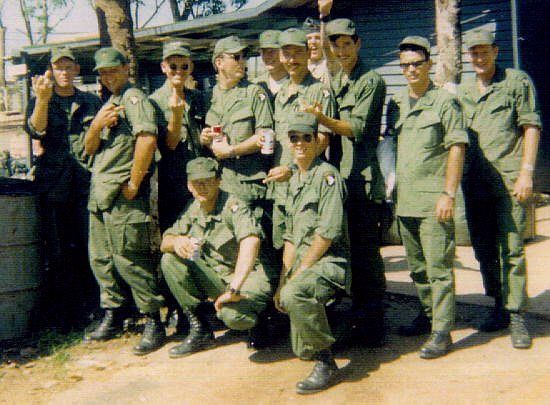
Standing left-to-right: Sawyer, Wynn, Bailey, Prazinko,
-Unknown-,
Nietsche, Olson, Morris, Goodwin, and Gale. Kneeling: Diehl and Kincaid
.
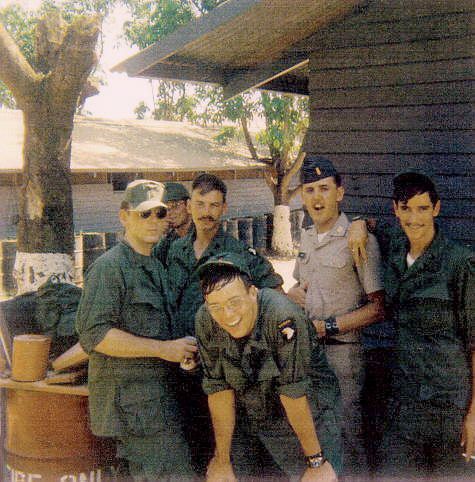
Left-to-right: Prezinko, -unknown-, Nietsche, Diehl,
Olson,
and Morris
For survival purposes, the term "If it ain't yours,
don't touch it" was impressed upon us that everything and anything could be booby-trapped.
It was there that I was first exposed to the rotating personnel and their far off,
tombstone gaze. What had they experienced here that would give them that expression?
I assumed I was on the road to find out.
------ At Duc Pho -----
My first reaction upon arriving at Duc Pho in late May 1970 was to that incredible line up of Charlie-models (UH-1C gunships) with their bright white, toothy smiles splashed across their noses. Wow! All Duc Pho needed was John Wayne standing on that flight line in a steel pot, yelling orders at new arrivals, "Come on fella! Don't just stand there gawking. Stow that gear and lets get to work!" Gunnery instructors at Rucker had told us: "You won't see no Charlie-models in Nam. They're all Cobras now!" Hey, don't believe everything you're told. The whole Americal Division was flyin' Charlie-models, with only a few exceptions like the "Blue Ghosts" and the "War Lords."
Duc Pho was right on the beach, and being from California and having spent my share of time on that beach, Vietnam (I-Corp) was a complete orientation scrambling for my senses. I was accustomed to the sun setting into the ocean, not rising out of it. The beach was supposed to be to the west, not the east. My initial flights were likened to someone with vertigo. When I thought I was heading north, I was going south, and so-on. The whack of just being in Vietnam was more than enough, not to have to deal with this. CW2 Charlie Uhlich must have thought I'd forgotten everything I'd ever known. I couldn't find the ashtray, or the a.s.h. receiver as he referred to it.
I was assigned to the 1st flight platoon, which was headed up by then-Captain Harold Alvord. He was from the northeast and had a wonderful accent and a great sense of humor. I think he was in his thirties and more than patient with my rookie blunderings. I respected his professionalism as much as anyone I've ever worked or flown with. I had a great cassette of him and others singing the most entertaining and rankest of 'alley' songs I'd ever heard, until I returned home and a now-distant relative erased it for some Beatles bubble gum songs. Butch Elliott claims he has a reel-to-reel of this performance, but we may never know for sure.
FNG WO1 Fred Thompson, pre-sexy mustache, June 1970.
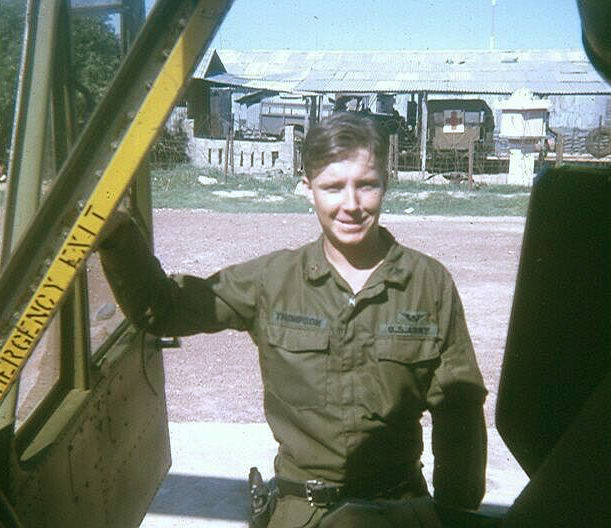
Well, I believe there was about eight or nine of us from my flight class that got assigned to the 174th at nearly the same time. It was our only salvation to being the "FNG's" as we were somewhat of a mob unto ourselves. Len Mizer, Mark Stefan and Bruce Marshall went directly to the Sharks. Art Magee got a transition to scouts and returned to fly for the 11th Bde (Primo) out of Duc Pho. Mike Phillips flew slicks and eventually became the pilot for the CO of the 11th L.I.B., after surviving Lam Son 719. During Lam Son, Mike Phillips flew an aircraft off of LZ Scotch with almost a hundred holes in it. Me, Bob Gentry and Bob Hertle "the Turtle" went to the slicks.
On one of my first days in company, I recall finishing a meal in the mess hall and sauntering across the nearly deserted company street to my new digs, only to observe then-2nd LT. John I. O'Sullivan eyeing my obvious 'newness' from a tilted back folding chair. He was balancing a bottle of Scotch on his right knee, like a cyclic stick, in front of the Shark hootch, and yelled at me as I passed in his review, "Hey new guy! You'll be dead in a week!"
Welcome to Vietnam.
I believed him. O'Sullivan was a Shark pilot, finishing his 2nd year in country. He would later be recognized as the "Army Aviator of the Year" for 1969 and 1970 (by Quad-A) and later be identified as the most decorated pilot of the entire conflict (see photo below). Seems he was also the Awards and Decorations officer. There were as many myths surrounding O'Sullivan than there were of the entire unit.
When I shared this experience (his greeting) with another senior pilot, he tells me "Stay away from him. He shot a guy here!" When I responded that he was a Shark pilot and that was his job, the guy tells me: "No, no, new guy. One of our guys!" (It was true, but it was actually an accident.) I've talked to crewmembers that worshiped him and others still that disliked him. Without a doubt, he was an exceptional character.
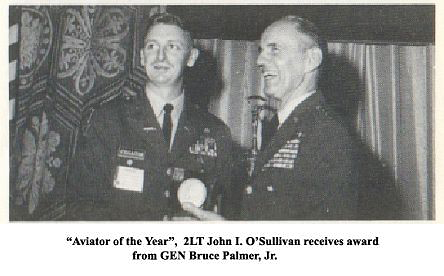
Due to a lack of available space in the first and second platoon pilot hooches,
Bob Gentry and I took up lodgings in the rear of the remains of the Misfits Kountry Klub. It
was a dump but we dug the size and space of the place. When the shack was vacant, folks used
to cannibalize it for anything not nailed down. When we moved in, portions of the floor were
missing and it was a real hazard just to walk through--and that was if you were sober. If you
did happen to fall through that floor, not only did you risk crushing a testicle; you could be
devoured by the sand fleas the size of kitchen flies.
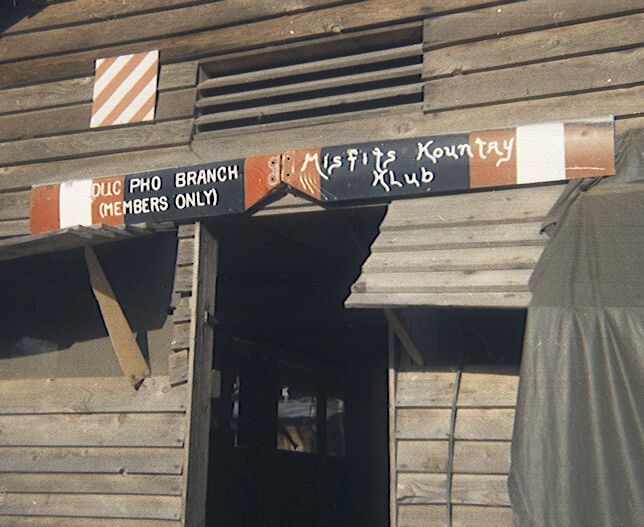
Above: The "Misfits" club turned into our (1st and 2nd Platoon "overflow") hootch 1970
It was not uncommon for transient types to use the place as a dumpster. It was really
amazing, the types of ordinance we found within it during our initial clean-out. It was
located right next to the small evac hospital's taxiway (and behind the officers club),
so every time a Dust Off came in or went out, everything you owned, or worse--were eating,
got a 1/4 inch coating of sand and dust. It was also not uncommon to wake up in the morning
with the feeling that your buddies had attempted to bury you in your sleep. If you slept on
one side during the night, you could count on one ear being full of dirt by morning.
Another advantage (?) it had was that it was right next to a piss tube at the rear of the
"O" Club. Not bad if you had to go in the middle of the night, but some of the fumes off
that thing--wafting about on a hot, still night--could level a city. We fixed the place up
and were the only residents for about two months. I stayed until Lt. Wayne Mullally moved
into the RLO's hootch and I got his room in the 1st platoon hootch (up-wind of 'the tube').
Life at Duc Pho was entertaining, to say the least. Pilots like Rick Gregore played the
guitar after a couple of beers and evenings were a lot of fun in and about the officers club.
Card games and fooling around with expensive cameras were generally more fun than just writing
letters all the time. If a pilot or crewmember had a particularly 'close call' by day, and had
the good fortune to survive, it was a good bet he'd be sharing his tale that night in "the
chair" in the O club. And, like any good aviator's war story, it was expected to start with:
"And this ain't no shit . . . There I was . . .!"
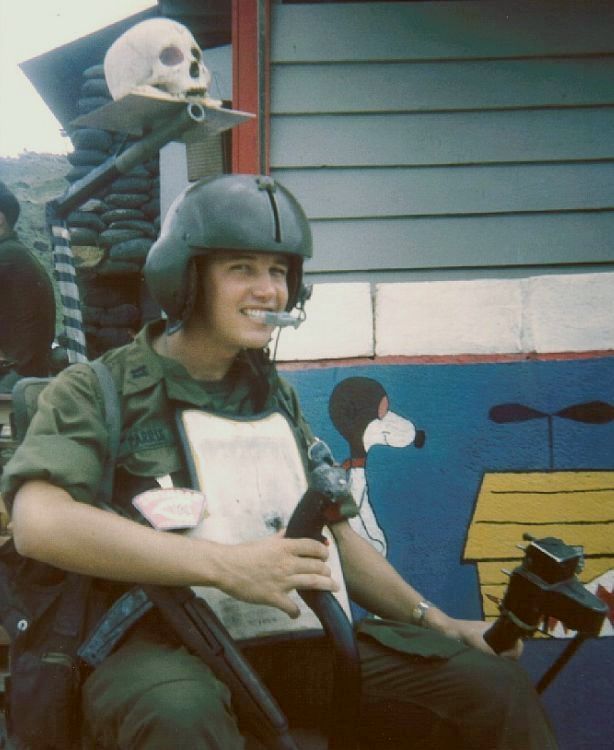
CPT Ken Parris (our XO) in the "No shit..."
Chair 1970. Just before he left the Unit, the Sharks gave him a patch that read "Shithead 6". He's wearing it in this photo. (photo property of Bruce Marshall)
The "chair" was a huey seat, mounted on rollers that sported a .51 cal
hole right through the bottom where a good pilot's testicles would rest. There was a cyclic
control stick attached to the bottom, that when the story teller began his tale, he would
activate the intercom switch that in turn would light up the Viet Cong skull that hung over
the head of the speaker. A guy in avionics had wired up the skull so the eyes shown bright
red. The 176th Muskets used to drink a rude alcoholic concoction, as an initiation into their
number, from a VC skull. The telling of a tale, seated below a glowing dink skull, was a much
more civilized approach to this form of entertainment.
------------------------
End of Part 2 of 20 Parts.
Click on the beacon to go to Part 3

|
